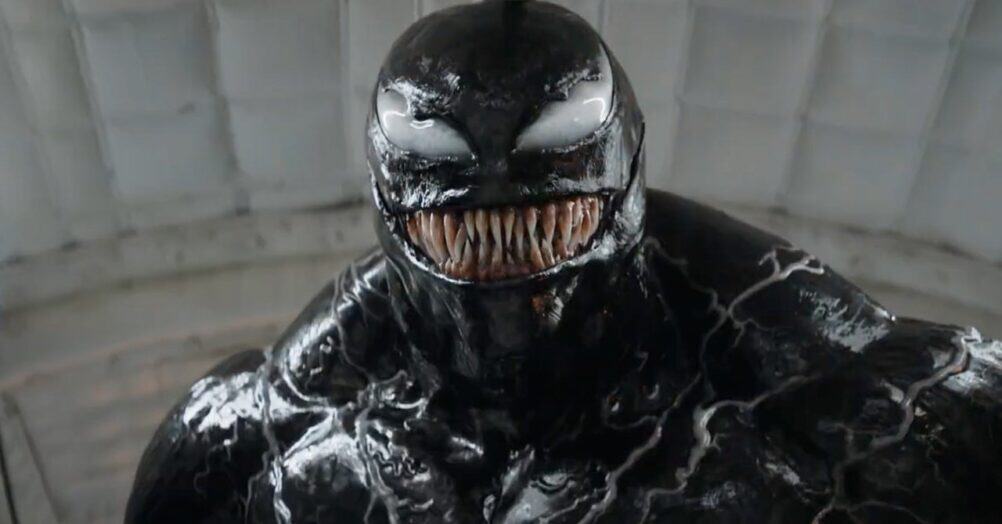Last Updated on June 25, 2024
Many genre fans are fascinated with the grindhouse era, and with the idea of watching movies – exploitation flicks, martial arts movies, low budget horror films, etc. – at the rundown grindhouse theatres that stood on 42nd Street in Manhattan, a place that was said to be dangerous and populated by some… we’ll call them unique individuals. One cinema fan who had the time of his life watching movies on 42nd Street back then was Frank Henenlotter. He was so enamored with the whole scene, he was inspired to make a movie right there in the 42nd Street area – and that’s how we got Basket Case (watch it HERE), the subject of this episode of The Best Horror Movie You Never Saw.
CREATORS / CAST: About a decade after directing a circumcision-themed short film called Slash of the Knife, which got theatrical play when paired with John Waters’ Pink Flamingos, Frank Henenlotter decided to team up with his friend Edgar Ievins to make a feature film. This was really done on a whim, with no larger goal than getting their movie shown in a theatre on 42nd Street. They scraped together some cash and dove into production with an initial investment of eight thousand dollars a piece, Henenlotter writing and directing the film and Ievins serving as producer.
The idea for Basket Case began with an image that Henenlotter imagined: the sight of a man walking around New York City, carrying a wicker basket with a monster inside of it. As intrigued as he was by this visual, he found the script tough to crack because he couldn’t figure out exactly why someone would want to keep a monster in a basket. The answer to the problem struck him while he was at the Nathan’s hot dog stand in Times Square: the guy is taking care of this monster because it’s his brother. Once Henenlotter came to that realization, Basket Case started flowing so quickly that he was writing dialogue on napkins before he even left Nathan’s that day.
Since Basket Case was made on such a low budget, it’s no surprise that it wasn’t just Henenlotter’s feature debut, it was also the feature debut for many of the cast members – and for several of them, it was the only movie they were ever in. Kevin Van Hentenryck, who had been in Slash of the Knife, was cast to play the lead character Duane Bradley, that young man who keeps his monstrous brother in a basket. Terri Susan Smith of the punk band The Tattooed Vegetables was cast as Duane’s love interest Sharon, and had to wear a wig in all of her scenes because her head was shaved. This was the only time she ever acted. Diana Browne, Lloyd Pace, and Bill Freeman earned their sole feature credits as a trio of people Duane and his brother are holding a grudge against. Robert Vogel and Joe Clarke were cast as notable characters at the hotel Duane and his brother stay in during their time in Manhattan, and Beverly Bonner – who would go on to be in every genre movie Henenlotter made after this – took on the role of Casey, the friendly prostitute next door.
But above all, the real star of this film is the character that draws us to Basket Case in the first place. The monster in the basket. Duane’s brother, Belial. Described as looking like a “squashed octopus”, because Henenlotter had originally envisioned him having a tentacle that didn’t make it into the film, Belial is an odd little fellow designed by effects artist Kevin Haney and brought to the screen through a mixture of puppetry and stop-motion animation. This character has some serious issues, and he makes a mess of several of his co-stars.
BACKGROUND: Basket Case took more than a year to shoot, because production would start and stop based on how much money Henenlotter had on hand at any given time. This was just part of the reality of making a low budget movie, and everyone involved knew what they were getting into. Henenlotter shot it on 16 millimeter and handled the editing himself, and the only trouble he ran into during the making of the movie – other than the fact that he kept running low on cash – was a crowd control issue when shooting scenes on 42nd Street. Random pedestrians would wander in front of the camera, and there was one incident where a storeowner threatened to kill Henenlotter and the crew because he thought they were a TV news crew trying to film his place of business. Once the director explained what was going on, the guy didn’t have any issue with having his store being shown in a horror movie.
As production went on, the tone of the film began to evolve. Although Henenlotter had chosen to make his first feature a horror movie because it was something that could be made cheaply and still have a good chance of landing some kind of distribution, he could see that his film wasn’t turning out to be terrifying. So he leaned into that, adding more humor, figuring that if the movie wasn’t going to work as a straightforward horror film, it could sell as a horror comedy. And even though Henenlotter has gone on to make several more movies that are considered to be part of the horror genre, he doesn’t consider himself to be a horror movie director, because none of his movies were intended to be outright scary. He prefers to call them exploitation movies, because they’re all “wacked out comedies” at their core, with horror, gore, and gratuitous nudity mixed in. He said, “I have the elements of exploitation in all of my films. It gives me a certain freedom. If I had to make a movie where I had to worry about making an audience jump, I wouldn’t be interested. I like the fact that I can make them laugh or get grossed out. That to me is more fun. … Exploitation films are what I grew up with, it’s the kitchen sink approach.”
Just as he was hoping, he was able to secure a distribution deal for Basket Case soon after it was completed and screened at the Cannes Film Festival. The problem was, part of the distributor’s plan to present the film as a comedy included removing all of the gore. Against Henenlotter’s wishes, the distributor cut out the bloodshed and released the film to a few theatres across the country as a midnight movie. According to the director, this release of a bloodless Basket Case was a failure. But then the legendary Joe Bob Briggs came into the picture.
The distributor planned to release Basket Case in Dallas, Texas, and since Joe Bob was already popular in the area for his “drive-in movie critic” newspaper articles, he was asked to host the premiere. That’s when Joe Bob revealed that he had already seen the movie – he was at the screening in Cannes, so the version he had seen was Henenlotter’s preferred cut, with the gore still intact. He refused to host the Dallas premiere unless he could show the uncut version. The distributor relented, and once the uncut Basket Case reached Texas, that’s when the film’s fortunes took a turn for the better. So basically, Basket Case was saved by Joe Bob Briggs.
The bloodless cut of the movie was replaced by the uncut version in all of the theatres that it had opened in, and people finally started going to see it. A theatre near where Henenlotter lived in New York had so much success showing Basket Case at midnight, they kept showing it for two and a half years straight. Despite this success, the distributor still went bankrupt, so Henenlotter took the film over to a different distributor that gave it a nationwide release, and not just midnight showings this time around. With more people having the chance to see it, Basket Case officially achieved cult status – which isn’t something Henenlotter was extremely enthusiastic about. The more viewers his movie was able to reach, the more embarrassed he became. He said, “I was horrified at the end result. One of the reasons why I did the movie was because I thought no one would really see it. I thought it would play on 42nd Street, no one would see it, and my sins would never be uncovered. If I thought I was smart enough to make a cult movie, I would have messed it up so much that it would be forgotten about.”
WHAT MAKES IT GREAT: The filmmaker may be embarrassed that so many people have seen his work, but Basket Case absolutely deserves the cult following that it has. The dirt cheap, D-I-Y look and feel adds to its charm, and given that this was meant to be a tribute to 42nd Street, it wouldn’t have been appropriate for it to look glossy and pristine anyway.
At its core, the film tells a simple revenge tale, but the setting and characters make it unique. There have been a lot of revenge movies, but how many of those were about formerly conjoined twin brothers seeking revenge on the doctors who separated them? And no other movie out there has Belial – well, except for Basket Case 2. And Basket Case 3.
Kevin Van Hentenryck turned in a great performance as Duane, the brother who can actually make his way around the outside world and interact with regular people without terrifying them. There’s a major conflict within this character, as he loves and cares about his mutant brother, he wants to assist him on this mission of revenge, but at the same time it’s clear that Duane really wants to have a normal life. He wants to have friends. He wants to have a girlfriend, without Belial interfering with the relationship. Beverly Bonner and Terri Susan Smith both do great work as the characters Duane connects with the most in Manhattan. The friendship Duane develops with Bonner’s Casey is somewhat surprising, as you would usually expect the Casey character to be someone Duane has to be wary of. Instead, she’s one of the only people in Manhattan who has his back and doesn’t want to see him get ripped off.
Smith’s performance wouldn’t have fit into just any movie, but it’s pitch perfect for this one. She delivers comedic lines very well, but things take a dramatic turn the longer she’s around Duane. And then Sharon is put in a really horrible situation by the end of the film.
While those characters carry the majority of the running time, Belial emerges from his basket now and then to spice things up with murder and mayhem. Even though this character is only played by a puppet, Henenlotter still manages to make us understand where he’s coming from. He was treated as a freak from the moment he was born, so despised by his father that he was named after a demon. Duane and Belial didn’t want to be separated, their father demanded it and forced the twins to undergo a back-alley surgery that ended with Belial getting dumped in the trash. It’s no wonder he’s bloodthirsty and out for revenge. Once we understand Belial, Henenlotter also makes us just as conflicted about the character as Duane is. We appreciate when Belial claws somebody to death or slams their face into a bunch of scalpels, but we can also see that he needs to be taken out of the equation before he ruins Duane’s life with his jealousy and homicidal rage, not to mention the telepathic connection he torments his brother with.
BEST SCENE(S): Of course, most of the best scenes have Belial at the center of them, even if only part of him is being glimpsed in the scene, or if he’s barely moving. The most we see Belial move comes in an amazing stop-motion animated sequence. Left alone in the hotel room while Duane goes on a date with Sharon, Belial crawls out of his basket and wrecks the room in a fit of jealousy. Henenlotter animated this sequence himself, a job he found to be quite challenging because he didn’t have the patience to do it properly. Feeling that the sequence was turning out to be choppy and lousy, he got so frustrated that he stopped working on it and threw the reel of film across the living room in his apartment. He then just left the film on the floor of the living room for a couple months, to torture himself for making something that was so bad.
Thankfully, he eventually returned to the sequence and ended up putting it in the film, giving us one of its most entertaining scenes. This may not be the flawless work of Willis O’Brien or Ray Harryhausen, but it’s awesome to see Belial move around in stop-motion nonetheless.
PARTING SHOT: Obviously Henenlotter can be a harsh critic of his own work, and while he didn’t want a lot of people to see Basket Case, I hope his embarrassment has been replaced with pride in the long run. This film’s success and cult following is a great achievement for someone who put his movie together piece by piece as the money came in. Few filmmakers would have even attempted to bring something like Belial to the screen when they had so little cash and resources to work with, but Henenlotter forged ahead and brought us an unforgettable character in a movie that’s worth watching more than once.
When even the great Joe Bob Briggs has said that he could watch Basket Case a thousand times and not get tired of it, naming it the ultimate midnight movie, there’s no question that Henenlotter made something special here.
Some previous episodes of the Best Horror Movie You Never Saw series can be seen below. To see more, and to check out some of our other shows, head over to the JoBlo Horror Videos YouTube channel – and subscribe while you’re there!



















Follow the JOBLO MOVIE NETWORK
Follow us on YOUTUBE
Follow ARROW IN THE HEAD
Follow AITH on YOUTUBE